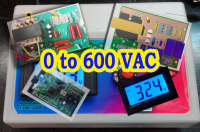AC voltage generator 0 to 600V

AC voltage generator 0 to 600V
I was needing a generator to test some voltage transducers that I use to monitor the voltage in automation stations, electric motors and other components that I use in my work. I need to know if the voltage is active, if there was a voltage drop or some defect in the voltage. The transducers receive alternating voltage from 0 to 600VAC (some have a full scale of 500 VAC) and transform this voltage signal into a process signal in current from 4 to 20 milliamps (PLC analog signal standard). However, I did not have an AC voltage generator to generate the test signal in the lab to service these transducers. The tool I used to generate the AC voltage signal was a transformer with primary at 110V and secondary with 10 step taps (0V, 62.5V, 125V, 150V, 200V, 250V, 300V, 375V, 450V, 500V 600V ) at its output.
I felt the need for a device that would provide me with more precision, being able to check all the voltages I wanted within the range of the transducer. I started to develop this AC voltage generator and now I am showing it.
At first I did several tests with voltage multipliers, trying to get the voltage from 0 to 600 Volts AC. Then I tried to make an electronic sinusoidal oscillator and feed an inverting transformer to reach the desired voltage, which was also unfeasible. Finally, there were some old voltage transducers (0-600 VAC to 4-20mA) that had at their input the transformer used in the final circuit. So I got something that was functional.
The circuit is very simple, being capacitively isolated from the mains by means of polyester capacitors. It has two sources, one only to feed with 12V DC the Voltmeter AC full-scale 1000VAC. This voltmeter was not very easy to find, since most digital voltmeters have a full scale of 500 ACV. Using two potentiometers, the first one for VCoarse, a 4W wire potentiometer, the other for Vfine, multiturn potentiometer, I can make the voltage range from zero to 40 Volts. After modulating the amplitude, I send this signal to a small transformer that has a primary of 35V and a secondary of 600 Volts, thus obtaining a signal from 0 to 600 V AC sinusoidal.
The output of the circuit is high impedance and low current, but it is already possible to excite the transducers that I submit to the tests, because they have high input impedance, not requiring much current for operation.
I felt the need for a device that would provide me with more precision, being able to check all the voltages I wanted within the range of the transducer. I started to develop this AC voltage generator and now I am showing it.
At first I did several tests with voltage multipliers, trying to get the voltage from 0 to 600 Volts AC. Then I tried to make an electronic sinusoidal oscillator and feed an inverting transformer to reach the desired voltage, which was also unfeasible. Finally, there were some old voltage transducers (0-600 VAC to 4-20mA) that had at their input the transformer used in the final circuit. So I got something that was functional.
The circuit is very simple, being capacitively isolated from the mains by means of polyester capacitors. It has two sources, one only to feed with 12V DC the Voltmeter AC full-scale 1000VAC. This voltmeter was not very easy to find, since most digital voltmeters have a full scale of 500 ACV. Using two potentiometers, the first one for VCoarse, a 4W wire potentiometer, the other for Vfine, multiturn potentiometer, I can make the voltage range from zero to 40 Volts. After modulating the amplitude, I send this signal to a small transformer that has a primary of 35V and a secondary of 600 Volts, thus obtaining a signal from 0 to 600 V AC sinusoidal.
The output of the circuit is high impedance and low current, but it is already possible to excite the transducers that I submit to the tests, because they have high input impedance, not requiring much current for operation.



Discussie (1 opmerking(en))